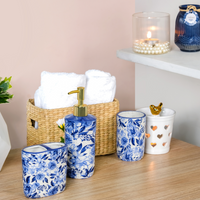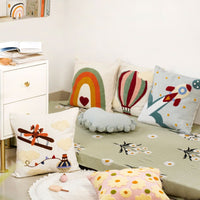Do you know what has witnessed centuries of human evolution in silence? Mirrors. It started from the moment humankind first gazed at their reflection in a pool of water to later making glass masterpieces; mirrors have been our silent companions throughout. They have been by our side, transforming our dreams into reality and reflecting not just faces but emotions, aspirations and even myths.
Today, these reflective surfaces are more than just any functional objects. They are statement pieces that breathe life into our spaces. So do you know what secrets lie behind these gleaming surfaces? Let’s understand the fascinating journey of mirrors through time.
Mirror Origin: Early Mythical Believes
Long before mirrors became household essentials, they were shrouded in mysticism. These reflective surfaces are woven into the fabric of ancient beliefs. In many cultures, mirrors were thought to be the windows to the soul, gateways to the otherworldly realms or even traps for evil spirits. The Greeks even believed that mirrors held prophetic powers. They were bronze disc-polished to perfection, and were used by oracles to divine the future. In China, the “magic mirrors” of the Han dynasty were said to reveal hidden truths, reflecting not just images but the essence of a person’s spirit.
There are even more intriguing superstitions surrounding mirrors. Several cultures around the world believed that breaking a mirror would fracture one’s soul and bring seven years of misfortune. Meanwhile, there were other sections too that revered mirrors as protective charms and used these surfaces to repel evil spirits or ward off bad energy.
Mythical narratives reveal that mirrors were never just about appearances. They were about perceptions, mysteries and deep human desire to understand the unseen. It’s a history as reflective as the surfaces themselves.
Mirrors & Myths
- In Russian and Eastern European folklore, it was believed that an uncovered mirror could trap a spirit or open a gateway for malevolent beings during a death. During the mourning period of Shiva, Jews cover mirrors to discourage vanity and self-focus during the time of grief. The 19th-century Victorian England practised covering of mirrors as well. This practice was rooted in superstition and the fear of lingering spirits.
- When it comes to mirrors and myths, the most common one is - Seven Years Of Badluck. The concept traces its way back to the Romans, who believed that mirrors held a fragment of a person’s soul. According to the Roman lore, the human soul regenerates after every 7 years. If a mirror was broken accidentally or intentionally, it was believed that the reflected soul was damaged leading to misfortune for seven years. Breaking a mirror also symbolised a shattered harmony between the physical body and the spiritual essence.
- The theory of “Cursed Mirrors”, very commonly shown in horror movies, stems from an eerie blend of superstition, folklore and human fascination with the unknown. Cursed mirrors are said to carry the weight of sinister energies, misfortunes and evil spirits. The idea of cursed mirrors has often been used as a metaphor in folklore, representing the dangers of vanity or unchecked ambition.
For example, in European legends, witches or enchanters were said to gift cursed mirrors to their rivals. These mirrors, enchanted with dark magic, would slowly unravel the receiver’s life, reflecting distorted visions of reality and sowing seeds of paranoia.
The Invention Of Metal Mirrors
Reflections were once as rare as passing clouds. One could only catch a glimpse of themselves from still waters of rivers or ponds, only if they were fortunate enough to be near them. That was the reality for early humans before the invention of metal mirrors that turned fleeting reflections into something tangible and lasting. The revolutionary creation of mirrors wasn’t just about vanity. It was a profound leap in how human beings saw themselves both literally and metaphorically.
The First Polished Surfaces
The origin of metal mirrors began around 4000 BCE, with the earliest known examples found in Mesopotamia, Egypt and China. Metal mirrors crafted from polished obsidian, copper and bronze were considered groundbreaking in standards for their time. These mirrors required immense labour to polish, signifying luxury and status. To hold a mirror in those days was to hold a piece of the cosmos. For people, it felt like carrying an artifact that captured the light of the sun and reflected the image of its beholder.
The invention of metal mirrors marked a transformative moment in human history. It led to a path of self-discovery, where people discovered a new way to perceive themselves. For the first time ever, individuals could study their own faces, observe their expressions and ponder their identities. In no time, mirrors became tools of self-discovery, inspiring philosophical questions about existence, beauty and the human spirit.
The origin of mirrors (metal) also reflected a lot about human ingenuity and artistry. Ancient artisans experimented with different alloys to improve reflectivity. The best example can be drawn from the mirrors of the Han Dynasty in China, where each piece was polished to perfection and featured intricate designs on the reverse. These mirrors reflected both the outer self and the cultural soul of their makers.
Another interesting thing about metal mirrors is the paradox that they had introduced. While they brought clarity to the physical image, they also highlighted the limitations of technology. The surfaces of these mirrors, even though reflective, distorted reality to some extent. This imperfection serves as a metaphor. Even when we think that we see ourselves clearly, there’s always more to uncover beneath the surface.
A Legacy That Shines On
Though metal mirrors eventually gave way to the glass mirrors we know today, their legacy remains. They were the first step in humanity’s quest to reflect, both outwardly and inwardly. The invention of metal mirrors was never just about creating an object. It was about sparking introspection, curiosity and innovation.
Their invention reminds us that even the simplest tools can change the way we see the world and ourselves. The creation and origin of mirrors isn’t just a story of metallurgy but a story of humanity’s eternal desire to connect with its own image and infinite possibilities. After all, isn’t every reflection a chance to ponder who we are and what we might become?
The Rise Of Glass Mirrors
The rise of glass mirrors wasn’t a sudden invention, but the result of centuries of trial and error, including serendipity and endless pursuit of perfection. By the 12th century, Venetian artisans, known to be the masters of glassmaking started crafting the first true glass mirrors. These mirrors made with silvered glass, offered an unprecedented level of clarity, surpassing anything the world had ever seen before.
Glass mirrors represented more than just a technological leap. They symbolised the shifting tide in human consciousness. No longer did people need the distorted surface of metal or the rippling surface of water to see themselves. The perfect and undistorted reflection in glass became synonymous with truth, precision and reality. For the first time ever, people could fully study their own image- sharp, clear and untainted. This clarity helped people analyse their outer selves and encounter every essence.
Role In Self-Exploration
With the origin of glass mirrors, something extraordinary happened. Human beings started to see themselves differently, not just physically but also philosophically. For the first time, questions like- “Who am I?” extended beyond the realm of metaphysical consideration and entered the domain of personal identity. In a matter of no time, glass mirrors became an everyday instrument of self-recognition. It gave us the power to reflect on our appearance, emotions and our place in the world.
Portal Of Infinite Realities
In the modern era, glass mirrors are no longer a rarity. They are omnipresent. Today, mirrors are woven into the fabric of our daily lives, from the bathroom to the living room, and from art galleries to design studios. They have become a metaphor for self-awareness, transformation and even escape. With every glance into a mirror, we are confronted not only with our outer selves but with other infinite possibilities.
Mirrors In Art & Culture
With the birth of glass mirrors, they had their existence intertwined with the fabric of art and culture. In their reflective depths, lies a profound metaphor for humanity’s eternal quest for self-understanding.
History stands as a witness to mirrors being a powerful symbol in artistic expression. Several artists used the power of mirrors to depict reality and at times, challenge it. Las Meninas, a painting by Diego Velázquez uses a mirror to disrupt traditional perspectives. The artist made a point here by questioning the role of the viewer and the subject.
Similarly, in literature, mirrors have been portals to other realms, as seen in Lewis Carroll’s famous work- Through The Looking Glass. Here mirror bridges the gap between the familiar and the fantastical. This recurring motif of mirrors as gateways reflects a universal human curiosity- what lies beyond the surface?
Culturally, mirrors have held deep mystical meanings all around the world. For example, in Japanese Shinto traditions, the Yata No Kagami mirror is considered a sacred piece of art that symbolises wisdom and self-reflection. Ancient Chinese beliefs saw mirrors as protectors, their surfaces repelling malevolent spirits. Across the world, mirrors are conduits of deeper truths and spiritual connections.
The Modern Era Of Mirrors
The modern era of mirrors depicts powerful design statements. No longer confined to their traditional roles, mirrors now shape the way we perceive space, light and most importantly, ourselves. With technology and artistry, mirrors have evolved into versatile creations, be they sleek, ornate, minimal or eclectic.
In contemporary homes, mirrors create the illusion of space, amplify natural light and add layers of textures to interiors. Modern-day homes utilise mirrors not just for practical uses, but also to showcase the personality of the space they inhabit.
The good news happens to be that the evolution aligns perfectly with the ethos of Nestasia’s designer mirrors. Made with an eye for detail, and a focus on aesthetics, mirrors from Nestasia are more than just decorative items. These mirrors can be a statement piece commanding attention. They can add that minimalist touch, quietly enhancing a room.
Conclusion
Mirrors have journeyed through time more than just objects. They have been silent witnesses to our evolution, dreams and desires, framing not just our faces but also our histories, philosophies and aspirations.
Today mirrors are omnipresent and their essence remains deeply profound. They remind us to not look closer, not just at the surface level but at the infinite layers of meaning beneath. A well-chosen mirror doesn’t just reflect your surroundings, it transforms them. As you stand before one today, know that you are not simply gazing at your reflection. You are also staring at the countless stories, dreams, and moments it has quietly preserved through time.





















